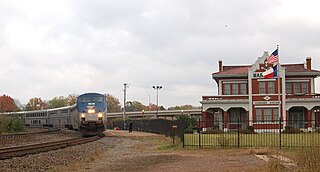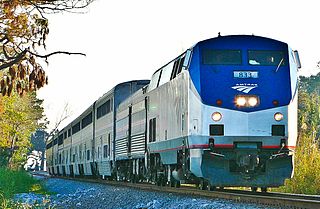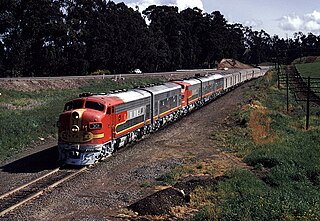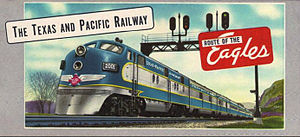
The Texas Eagle is a long-distance passenger train operated daily by Amtrak on a 1,306-mile (2,102 km) route between Chicago, Illinois, and San Antonio, Texas, with major stops in St. Louis, Little Rock, Dallas, Fort Worth, and Austin. Three days per week, the train joins the Sunset Limited in San Antonio and continues to Los Angeles via El Paso and Tucson. The combined 2,728-mile (4,390 km) route is the longest in the United States and the second-longest in the Americas, after the Canadian.

Dallas Union Station, officially Eddie Bernice Johnson Union Station, also known as Dallas Union Terminal, is a large intermodal railroad station in Dallas, Texas. It is the third busiest Amtrak station in Texas, behind Fort Worth Central Station and San Antonio station. It serves DART Light Rail Blue and Red lines, Trinity Railway Express commuter rail and Amtrak intercity rail. It is located on Houston Street, between Wood and Young Streets, in the Reunion district of Downtown Dallas. The structure is a Dallas Landmark and is listed on the National Register of Historic Places.

The Missouri Pacific Railroad, commonly abbreviated as MoPac, was one of the first railroads in the United States west of the Mississippi River. MoPac was a Class I railroad growing from dozens of predecessors and mergers. In 1967, the railroad operated 9,041 miles of road and 13,318 miles of track, not including DK&S, NO&LC, T&P, and its subsidiaries C&EI and Missouri-Illinois.

The Sunset Limited is a long-distance passenger train operated by Amtrak on a 1,995-mile (3,211 km) route between New Orleans, Louisiana, and Los Angeles, California, with major stops in Houston, San Antonio, El Paso, and Tucson. Introduced in 1894 by the Southern Pacific Railroad, it is the oldest continuously operating named train in the United States.

The Texas and Pacific Railway Company was created by federal charter in 1871 with the purpose of building a southern transcontinental railroad between Marshall, Texas, and San Diego, California.

The Kansas City Mule and St. Louis Mule were a pair of 283-mile (455 km) passenger trains operated by Amtrak running between St. Louis and Kansas City, Missouri as part of the Missouri Service train network. Also operating over this route was the Ann Rutledge, which originated in Chicago. In January 2009, Amtrak consolidated these trains under the name Missouri River Runner.

The San Francisco Chief was a streamlined passenger train on the Atchison, Topeka, and Santa Fe Railway between Chicago and the San Francisco Bay Area. It ran from 1954 until 1971. The San Francisco Chief was the last new streamliner introduced by the Santa Fe, its first full train between Chicago and the Bay, the only Chicago–Bay Area train running over just one railroad, and at 2,555 miles (4,112 km) the longest run in the country on one railroad. The San Francisco Chief was one of many trains discontinued when Amtrak began operations in 1971.

The Denver Zephyr was a streamlined passenger train operated by the Chicago, Burlington and Quincy Railroad between Chicago, Illinois, and Denver, Colorado. In peak years it ran to Colorado Springs. It operated from 1936 to 1973. The Denver Zephyr continued operating after the Burlington Northern Railroad merger in 1970. BN conveyed the train to Amtrak in 1971; Amtrak merged it with the Denver–Oakland City of San Francisco to form the San Francisco Zephyr and dropped the "Denver" name in 1973.

The Sunshine Special was inaugurated by the St. Louis, Iron Mountain and Southern Railway,, on December 5, 1915, to provide a premium level of passenger train service between St. Louis, Little Rock, and destinations in Texas, United States, such as El Paso, San Antonio, Laredo and Houston. An auxiliary section of the train originated in Memphis, Tennessee, and linked with the train in Little Rock, Arkansas.

The Panama Limited was a passenger train operated from 1911 to 1971 between Chicago, Illinois, and New Orleans, Louisiana. The flagship train of the Illinois Central Railroad, it took its name from the Panama Canal, which in 1911 was three years from completion. For most of its career, the train was "all-Pullman", carrying sleeping cars only. The Panama Limited was one of many trains discontinued when Amtrak began operations in 1971, though Amtrak revived the name later that year and continued it until 1981.

Memphis Union Station was a passenger terminal in Memphis, Tennessee. It served as a hub between railroads of the Southwest, the Missouri Pacific Railroad and the St. Louis Southwestern Railway, and railroads of the Southeast, the Louisville and Nashville Railroad, the Nashville, Chattanooga and St. Louis Railway and the Southern Railway. The terminal, completed in 1912, was built in the Beaux-Arts style and was located on Calhoun Street, between south Second Street and Rayburn Boulevard. It was demolished in 1969. This location in south Memphis was approximately two blocks east of the other major Memphis railroad terminal, Memphis Grand Central Station.

The Rocky Mountain Rocket was a streamlined passenger train of the Chicago, Rock Island and Pacific Railroad. Rock Island's train numbers 7 and 8 ran between Chicago's LaSalle Street Station and Denver's Union Station and Colorado Springs, Colorado. The Rocky Mountain Rocket ran from 1939 to 1966; the train was discontinued prior to the creation of Amtrak in 1971.

Little Rock Union Station, also known as Mopac Station, is a train station in Little Rock, Arkansas, United States served by Amtrak, the national railroad passenger system.

The Inter-American was a passenger train operated by Amtrak between Chicago and Laredo, Texas. Its route changed over time and was eventually replaced by the Texas Eagle.

The Texas Chief was a passenger train operated by the Atchison, Topeka and Santa Fe Railway between Chicago, Illinois, and Galveston, Texas. It was the first Santa Fe "Chief" outside the Chicago–Los Angeles routes. The Santa Fe conveyed the Texas Chief to Amtrak in 1971, which renamed it the Lone Star in 1974. The train was discontinued in 1979.

The Texas Special was a named passenger train operated jointly by the Missouri–Kansas–Texas Railroad and the St. Louis–San Francisco Railway. It was the flagship of both these lines, operating between St. Louis, Missouri, and San Antonio, Texas, from 1915 until 1959, after which time the Katy changed the northern destination from St Louis to Kansas City after the Frisco discontinued service from St. Louis.

The Spirit of St. Louis was a named passenger train on the Pennsylvania Railroad and its successors Penn Central and Amtrak between New York and St. Louis, Missouri. The Pennsylvania introduced the Spirit of St. Louis on June 15, 1927, replacing the New Yorker (eastbound) and St. Louisian (westbound); that September its schedule was 24 hr 50 min each way.

Hope station is a passenger rail station in Hope, Arkansas. The station is located on Amtrak's Texas Eagle line. Trains run daily between Chicago, Illinois, and San Antonio, Texas, and continue to Los Angeles, California, 2,728 miles (4,390 km) total, three days a week.
The Penn Texas was a named passenger train of the Pennsylvania Railroad that ran from New York City's Pennsylvania Station to St. Louis' Union Station from 1948 to 1970. The train also had a branch from Harrisburg, Pennsylvania to Washington, D.C., via York, Pennsylvania and Baltimore, Maryland. The train offered sleeping cars that would run continuous to different Texas branches to El Paso, Houston and San Antonio over the Missouri Pacific's Texas Eagle. Accordingly, this service was the longest distance that an American railroad offered for through sleeper service to the east coast, with exception of trains running from California to New York. Coach passengers heading to Texas would need to change at St. Louis Union Station. Throughout this period, the Pennsylvania's competitor, the New York Central Railroad operated a competing Southwestern Limited which also offered sleeping cars which would hitch with Texas Eagle trains.

Laredo station is a former Amtrak and Missouri Pacific passenger train depot in Laredo, Texas. The station was the southern terminus of the Inter-American, the last Amtrak train to serve Laredo, which ran from 1973 to 1981.





















